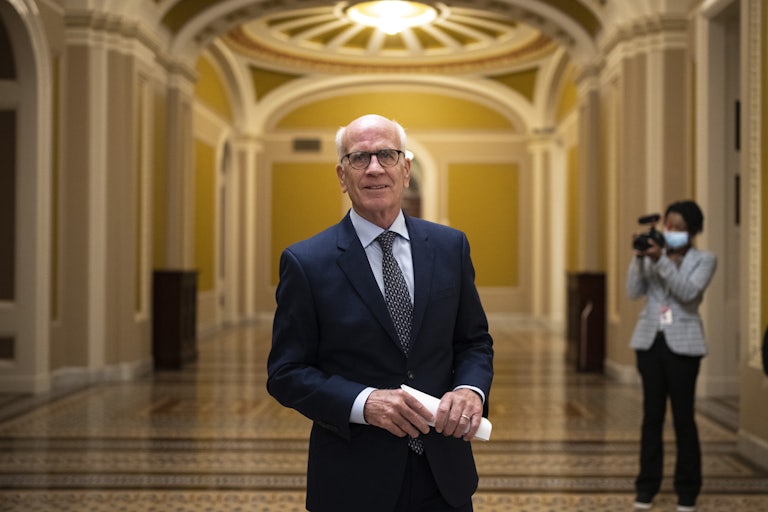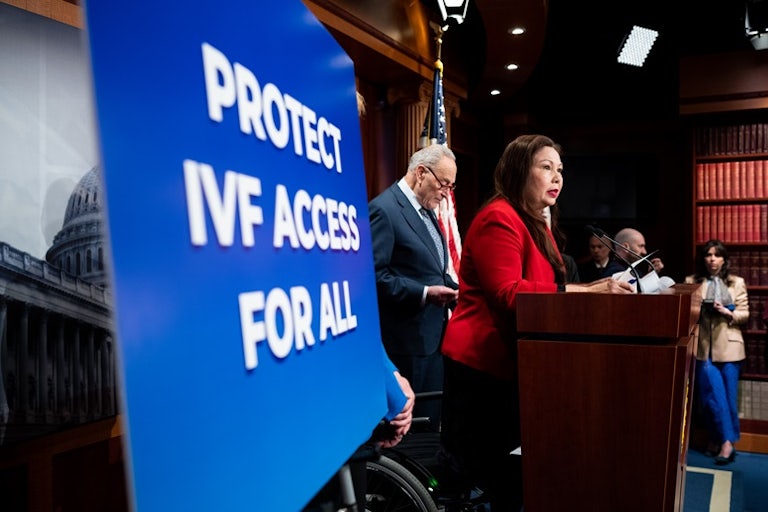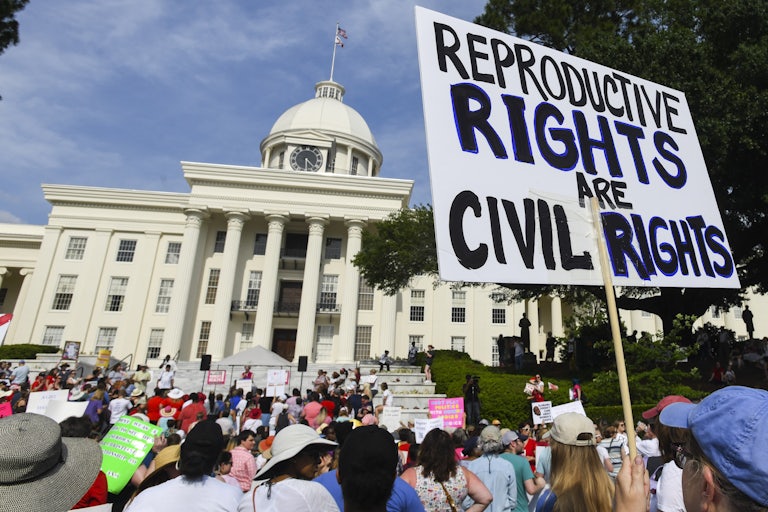The Supreme Court Could Change How We Think About January 6
The high court will weigh in on whether hundreds of rioters were properly charged in a case that may have big ramifications for prosecutions yet to come.

Another week, another blockbuster Supreme Court case that could have lasting consequences for American politics: On Tuesday, the nation’s high court heard arguments in a case challenging whether federal prosecutors could charge rioters in the January 6, 2021, siege of the Capitol using a law that criminalizes what is known as “obstructing an official proceeding.” The Justice Department has argued that defendants violated this law, enacted in the wake of the Enron scandal more than two decades ago, by attempting to prevent the certification of President Joe Biden’s Electoral College victory in 2020.
More than 350 people have been charged, and more than 100 have pleaded guilty or been convicted, under the statute, which has a maximum sentence of 20 years in prison. Perhaps the most prominent person charged under the federal obstruction statute: former President Donald Trump.
But the justices seemed to be divided on the issue in arguments on Tuesday. Some conservative justices, who comprise the majority of the court, worried that the statute grants federal prosecutors overly expansive authority to target protesters. “Would a heckler in today’s audience qualify, or at the State of the Union address? Would pulling a fire alarm before a vote qualify for 20 years in federal prison?” Justice Neil Gorsuch asked.
Justice Clarence Thomas—whom Democrats hoped would recuse from the case, due to the efforts by his wife, Ginni Thomas, to overturn the 2020 election—questioned whether the law had been used in relation to other violent protests. (Although the case will not be decided for months, federal judges in lower courts have allowed several of the defendants who were imprisoned because of the law to be released from custody.)
The Sarbanes-Oxley Act of 2002 includes a provision that applies to anyone who “alters, destroys, mutilates, or conceals a record, document, or other object, or attempts to do so, with the intent to impair the object’s integrity or availability for use in an official proceeding,” or “otherwise obstructs, influences, or impedes any official proceeding, or attempts to do so.” The Biden administration’s arguments rest on the word “otherwise,” maintaining that it is a catchall that refers to obstruction that goes beyond the shredding of documents. But Chief Justice John Roberts argued that “the general phrase is controlled and defined by reference to the terms that precede it”—in this case, “alters, destroys, mutilates, or conceals.” (This would not be the first time the executive branch has been stymied by the judiciary in using Sarbanes-Oxley: In 2014, the Supreme Court limited the interpretation of the law outside of corporate fraud cases.)
Perspectives on the case from Capitol Hill, somewhat predictably, were divided along party lines. GOP Senator Josh Hawley argued that the federal application of Sarbanes-Oxley in this case ran “far, far afield” of the original intent of the law. “You want to charge rioters, go right ahead. Charge them with trespass, charge them with assault, charge them with whatever,” Hawley said. “They have applied that so broadly, and they’ve completely lifted it out of the records context, and that could be applied to just about any situation to any government proceeding.”
If the Supreme Court were to limit the use of the law, it’s unclear what effect this would have on prosecutions relating to the January 6 riot; many defendants, including the former police officer who brought this case before the court, were charged with multiple other crimes. Jack Smith, the special counsel overseeing the federal case against Trump, has argued that a narrower reading of the law would not prevent the former president from being prosecuted under the statute. The two obstruction counts against Trump involve him conspiring to create false slates of electors, which Smith says would apply even under a stricter interpretation of the statute.
“I’m curious to see what the Supreme Court will say, but nothing in that particular legal adjudication affects in any way our sense of the criminal character of the violent and fraudulent assault on the 2020 election,” said Democratic Representative Jamie Raskin, who was a member of the House select committee that investigated the riot in 2022. “I don’t think there’s any cause for a narrowing construction of that statute. But I think that if it did happen, again, it doesn’t change the essential character of the events we’re talking about.”
This article first appeared in Inside Washington, a weekly TNR newsletter authored by staff writer Grace Segers. Sign up here.
Vibe check: The future of the Affordable Connectivity Plan
I’ve previously written in this newsletter about the Affordable Connectivity Program, which helps connect millions of low-income Americans to the internet—and which will end in May if Congress does not approve additional funding. The program grew from a pandemic-era benefit, and has been used by around 23 million households. Despite bipartisan and bicameral support for the Affordable Connectivity Program Extension Act, which would boost funding for the program by $7 billion, the future of the bill is uncertain. Congress is preoccupied with a host of other priorities, including approving a supplemental package of aid to Ukraine, Israel, and the Indo-Pacific.
Despite these complications, a group of Democratic representatives is pressuring Johnson to take up the legislation. I spoke with Representative Annie Kuster of New Hampshire, the chair of the New Democrat Coalition, about how her caucus of centrist Democrats is pushing to keep the Affordable Connectivity Act a priority. This interview has been lightly edited and condensed for clarity.
The ACP is set to end in May. Do you believe Congress can approve legislation to extend the program before that deadline?
I certainly hope so. I mean, that’s our goal. We’ve waited too long, obviously. This was a bipartisan bill when it passed; the extension has two dozen Republican co-sponsors. And we were hoping that they would help us to get it to the floor quickly. Now we’re really running up against the deadline. And so we want to make sure that we keep the pressure on the House Republican leadership.
These enrollees are all across the country, in red and blue districts, so we’ve got to put aside partisan politics and work together. It’s a lifeline for American families, for students doing homework, or people applying for jobs. We have very low unemployment, and our companies are looking for people to do jobs, to cover their job openings. And if you don’t have the internet from home, you can’t apply for the job. You can’t look up the bus schedule to get to the job. You can’t be in touch with your employer to send or receive messages.
The way America works and lives, and the way our communities function—for schools, for hospitals—everyone has the expectation that people will be available via the internet. And 23 million Americans have had this access to affordable internet. We’ve been closing this digital divide. This is true for low-income communities, but it’s also true for rural communities like my district to provide access to affordable broadband. We did this during Covid because it became immediately apparent how important it was for telework, for telehealth, for education online. And then now it’s being stripped away—just in my own state, we’re talking about 40,000 households. So that is a significant number of people who will no longer be able to participate in the normal course with our community and with our economy.
What do you believe is the best pathway for approving the Affordable Connectivity Program extension?
Well, the best pathway would be to just attach it to a bill that’s going to be considered, and get it to the president for his signature as quickly as possible. If the Republican leadership is unwilling to do that, then we would have to consider alternative pathways.
What kind of bill would you want to see it attached to?
Whatever passes the relevancy test. It’s such a popular bipartisan program. It shouldn’t be difficult to identify it—you know, a path to get this done. This should be a priority, really, with the deadline bearing down on us?
Well, that does bring me to my next question. There is a lot happening in Congress right now.
Yes, yes. Maybe we could attach it to Ukraine aid. [Laughs]
How do you convince Speaker Johnson that this is a priority?
I think it’s so popular that we should be able to do it on suspension, and now we’ve got a few extra days here. Let’s do it on Friday under suspension. That might be the way to go.
[Author’s note: Approving a bill under suspension of the rules requires a two-thirds majority to pass.]
The bill does, as you mentioned before, have significant GOP support. But there are a few Republicans who say that the ACP is redundant or that it has not truly connected a meaningful number of Americans. How do you respond to those criticisms?
Twenty-three million Americans is a meaningful number to me, and certainly 40,000 households in New Hampshire. We’re a state that has, I think we’re at 2.3 percent unemployment.… We can’t afford to have 40,000 people isolated, not connected to our economy and our society to the extent that they can’t fill out a job application, they can’t apply for a new position, they can’t go online to get new skills. Health care is a great example. So much of health care is working your way up from an entry level [licensed nursing assistant] to getting your credentials, working your way up to nurse practitioner. The way these things happen is that people take classes online, over the weekend, at night. And you’re just, like, squashing all of that talent. I wish I had a sophisticated word. I’m just thinking of just pushing people down. You’re not giving people the opportunity to thrive, and it will impact our economy.
I have one health care provider with 750 openings, they need to be able to communicate with everybody. And if you take 40,000 people out of the pool of potential applicants, just simply because they don’t have access to know about the position, to look online for a job, to fill out the application, to pull down their transcript from their school—everything happens online. Put yourself in the position of trying to apply for a job and not being able to go on a computer. It’s ludicrous in this day and age. And so to me the ACP is the equivalent of basic infrastructure. It’s like having public roads and high winds and phones and everything that we need to function. This is the modern version. The twenty-first-century infrastructure includes access to affordable internet.
I would be remiss if I didn’t ask you a question related to the news of the week. So, specifically, consideration of the package of national security bills and what that could mean for Johnson if the House is able to pass this new legislation. Do you think Democrats would be prepared to vote to keep Johnson in office if there is a motion to vacate against him?
So what I have said publicly is that, first and foremost, we’re focused on the substance. So we are taking today to ensure and reassure ourselves that all the parts of the set package are included. So, aid to Ukraine, aid to Israel, humanitarian aid to Gaza; there’s a fourth piece that has to do with Taiwan. We need to absolutely confirm that all of the pieces [are there]. But if I accept your proposition that all of the pieces will be passed, I have said publicly that if he’s a man of his word, and he told me directly, personally, that that’s what would happen, then I would personally have no reason to remove him from the chair.
That seems like a very conditional statement.
Entirely. Entirely conditional. And frankly, I wouldn’t even make that decision until that decision had been made by my leadership. You will see Democratic unity on this issue. We will negotiate together. This will be in conjunction with a decision that’s made by our leadership, Leader Hakeem Jeffries and our whip, Katherine Clark. I would never get out in front of them.
What I’m reading
‘I’m gonna O.J. you’: How the Simpson case changed perceptions—and the law—on domestic violence, by Sonja Sharp in the Los Angeles Times
The coiled ferocity of Zendaya, by Matt Zoller Seitz in Vulture
The truth about organic milk, by Annie Lowrey in The Atlantic
How climate change turned camels into the new cows, by Chico Harlan, Rael Ombuor, and Malin Fezehai in The Washington Post
Into the Tubi-verse, by John Wilmes in The Ringer
How the dream of a financial aid upgrade became a nightmare, by Grace Segers in The New Republic. (It was recently pointed out to me by my mother, of all people, that I often include my own stories in the “What I’m reading” segment. To which I respond: How else will I get people to read what I write?)
Pet of the week

















